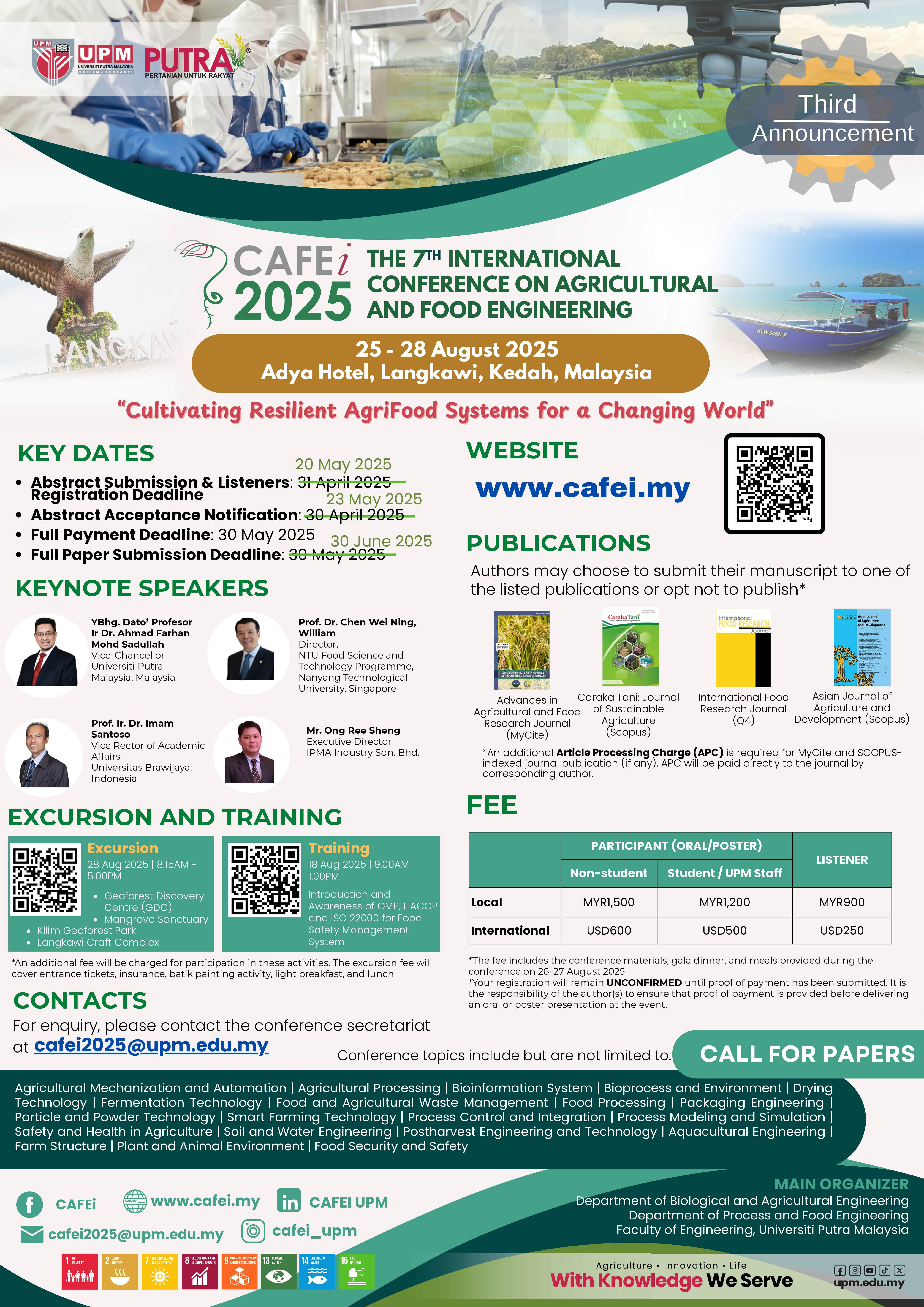Analysis for the Estimation of Harumanis Mango Ripeness Guide
DOI:
https://doi.org/10.36877/aafrj.a0000190Abstract
Harumanis mango ripeness guide is hardly to reach to predict the ripening stages in a such this emerging artificial intelligence commencing technology. The use of digital support tool for selective fruits in predicting the ripening stages should be subdued, exercising to be accessible by directive users. Having those lacks, this preliminary project is a first step to analyse the ripeness stages of harumanis mango referring to firmness, pulp colours and total soluble sugar (TSS) for digitalization purposes. Twenty-five harumanis mangoes harvested at week tenth were used, which had an average of mass for 417.96 ± 163.24 g. Five samples randomly selected in each stage by settling them under a room temperature and two days interval period. Findings showed the lowest TSS content uncovered at stage 2 for 6.94 Brix and the highest found at stage 5 for 15.02 Brix. The highest firmness unfolded in stage 2 with value of 2.902 kgf and the lowest discovered in stage 5 for 0.810 kgf. The pulp colours showed reduction of blue values for 70, activated at stage 3. The results suggested that harumanis mango started deteriorating after six days of room temperature storing period, this followed by rapid degradation of firmness and increasing of TSS value. Moreover, combinations colour values of red, green and blue composed constructive predictive yellowish variants throughout stages, positively useable to development of digital decision support tool.References
Bafor, E. E., Greg-Egor, E., Omoruyi, O., Ochoyama, E., & Omogiade, G. U. (2019). Disruptions in the female reproductive system on consumption of calcium carbide ripened fruit in mouse models. Heliyon, 5(9), e02397. doi:https://doi.org/10.1016/j.heliyon.2019.e02397
Barnea, E., Mairon, R., & Ben-Shahar, O. (2016). Colour-agnostic shape-based 3D fruit detection for crop harvesting robots. Biosystems Engineering, 146, 57-70. doi:https://doi.org/10.1016/j.biosystemseng.2016.01.013
Fukuda, S., Yasunaga, E., Nagle, M., Yuge, K., Sardsud, V., Spreer, W., & Müller, J. (2014). Modelling the relationship between peel colour and the quality of fresh mango fruit using Random Forests. Journal of Food Engineering, 131, 7-17. doi:https://doi.org/10.1016/j.jfoodeng.2014.01.007
Gan, H., Lee, W. S., Alchanatis, V., Ehsani, R., & Schueller, J. K. (2018). Immature green citrus fruit detection using color and thermal images. Computers and Electronics in Agriculture, 152, 117-125. doi:https://doi.org/10.1016/j.compag.2018.07.011
Gené-Mola, J., Vilaplana, V., Rosell-Polo, J. R., Morros, J.-R., Ruiz-Hidalgo, J., & Gregorio, E. (2019a). KFuji RGB-DS database: Fuji apple multi-modal images for fruit detection with color, depth and range-corrected IR data. Data in Brief, 25, 104289. doi:https://doi.org/10.1016/j.dib.2019.104289
Gené-Mola, J., Vilaplana, V., Rosell-Polo, J. R., Morros, J.-R., Ruiz-Hidalgo, J., & Gregorio, E. (2019b). Multi-modal deep learning for Fuji apple detection using RGB-D cameras and their radiometric capabilities. Computers and Electronics in Agriculture, 162, 689-698. doi:https://doi.org/10.1016/j.compag.2019.05.016
Gupta, N., & Jain, S. K. (2014). Storage behavior of mango as affected by post harvest application of plant extracts and storage conditions. Journal of food science and technology, 51(10), 2499-2507. doi:10.1007/s13197-012-0774-0
Islam, M. T., Shamsuzzoha, M., Rahman, M. S., Haque, M. M., & Alom, R. (2017). Influence of pre-harvest bagging on fruit quality of mango (Mangifera indica L.) cv. Molika. Journal of Bioscience and Agriculture Research, 15(01), 1246-1254.
Kasampalis, D. S., Tsouvaltzis, P., & Siomos, A. S. (2020). Chlorophyll fluorescence, non-photochemical quenching and light harvesting complex as alternatives to color measurement, in classifying tomato fruit according to their maturity stage at harvest and in monitoring postharvest ripening during storage. Postharvest Biology and Technology, 161, 111036. doi:https://doi.org/10.1016/j.postharvbio.2019.111036
Ketsa, S., Phakawatmongkol, W., & Subhadrabhandhu, S. (1999). Peel Enzymatic Activity and Colour Changes in Ripening Mango Fruit. Journal of Plant Physiology, 154(3), 363-366. doi:https://doi.org/10.1016/S0176-1617(99)80181-3
Liang, M., Su, X., Yang, Z., Deng, H., Yang, Z., Liang, R., & Huang, J. (2020). Carotenoid composition and expression of carotenogenic genes in the peel and pulp of commercial mango fruit cultivars. Scientia Horticulturae, 263, 109072. doi:https://doi.org/10.1016/j.scienta.2019.109072
Liu, S., Huang, H., Huber, D. J., Pan, Y., Shi, X., & Zhang, Z. (2020). Delay of ripening and softening in ‘Guifei’ mango fruit by postharvest application of melatonin. Postharvest Biology and Technology, 163, 111136. doi:https://doi.org/10.1016/j.postharvbio.2020.111136
Schulze, K., Nagle, M., Spreer, W., Mahayothee, B., & Müller, J. (2015). Development and assessment of different modeling approaches for size-mass estimation of mango fruits (Mangifera indica L., cv. ‘Nam Dokmai’). Computers and Electronics in Agriculture, 114, 269-276. doi:https://doi.org/10.1016/j.compag.2015.04.013
Srinivasa, P., Baskaran, R., Ramesh, M., Harish Prashanth, K., & Tharanathan, R. (2002). Storage studies of mango packed using biodegradable chitosan film. European Food Research and Technology, 215(6), 504-508. doi:10.1007/s00217-002-0591-1
Sudheeran, P. K., Love, C., Feygenberg, O., Maurer, D., Ovadia, R., Oren-Shamir, M., & Alkan, N. (2019). Induction of red skin and improvement of fruit quality in ‘Kent’, 'Shelly' and ‘Maya’ mangoes by preharvest spraying of prohydrojasmon at the orchard. Postharvest Biology and Technology, 149, 18-26. doi:https://doi.org/10.1016/j.postharvbio.2018.11.014
Downloads
Published
How to Cite
Issue
Section
License
Copyright (c) 2021 Zainal Abidin Arsat

This work is licensed under a Creative Commons Attribution-NonCommercial 4.0 International License.
Author(s) shall retain the copyright of their work and grant the Journal/Publisher right for the first publication with the work simultaneously licensed under:
Creative Commons Attribution-NonCommercial 4.0 International (CC BY-NC 4.0). This license allows for the copying, distribution and transmission of the work, provided the correct attribution of the original creator is stated. Adaptation and remixing are also permitted.

This broad license intends to facilitate free access to, as well as the unrestricted reuse of, original works of all types for non-commercial purposes.
The author(s) permits HH Publisher to publish this article that has not been submitted elsewhere.

.png)

.jpg)



